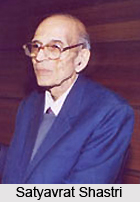 Satyavrat Shastri is the Sanskrit scholar writer and grammarian whose contribution to Indian literature has surpassed the boundaries of the known and the much acquainted.
Satyavrat Shastri is the Sanskrit scholar writer and grammarian whose contribution to Indian literature has surpassed the boundaries of the known and the much acquainted.
Early Life of Satyavrat Shastri
Satya Vrat (or Satyavrat) Shastri was born 29 September 1930 is a highly decorated Sanskrit scholar, writer, grammarian and poet from India. He has written three Mahakavyas, three Khandakavyas, one Prabandhakavyas and one Patrakavya and five works in critical writing in Sanskrit. His important works are Ramakirtimahakavyam, Brahattaram Bharatam, Sribodhisattvacharitam, Vaidika Vyakarana, Sarmanyadesah Sutram Vibhati, and "Discovery of Sanskrit Treasures" in seven volumes.
He is currently an honorary professor at the Special Centre for Sanskrit Studies, Jawaharlal Nehru University, and New Delhi. He was the Head of the Department of Sanskrit and the Dean of the Faculty of Arts at the University of Delhi, where he was the Pandit Manmohan Nath Dar Professor of Sanskrit.
During his career he has won many national and international awards, including, the Sahitya Akademi Award for Sanskrit, given by Sahitya Akademi, India`s National Academy of Letters, in 1968 for his poetry work, Srigurugovindasimhacharitam then in 2006, he became the first recipient of the Jnanpith award in Sanskrit Language (conferred in 2009 by his disciple and Thailand`s Princess Maha Chakri Sirindhorn).
Career of Satyavrat Shastri
Prof. Shastri received his early education under his father, Shri Charu Deva Shastri, a renowned scholar. Thereafter, he moved to Varanasi, where he studied under Pandit Shukdev Jha and Dr. Siddheshwar Varma.
He received his B.A. Hons. and M.A. in Sanskrit from the Punjab University, and his PhD from the Banaras Hindu University.
He joined the University of Delhi soon after, where for the next forty years of his teaching career, he held important positions as the Head of the Department of Sanskrit, and the Dean of the Faculty of Arts. Satya Vrat Shastri was also the Vice-Chancellor of Shri Jagannath Sanskrit University, Puri, Orissa, and a visiting professor at the Chulalongkorn and Silpakorn Universities in Bangkok, as well as the Northeast Buddhist University, Nongkhai, Thailand, the University of TÂbingen, TÂbingen, Germany, the Catholic University, Leuven, Belgium, and the University of Alberta, Edmonton, Canada. He also taught Sanskrit to Thailand`s Princess Maha Chakri Sirindhorn.
Satya Vrat Shastri has written many important poetic works in Sanskrit, the most important being his rendition from Royal Thai into Sanskrit, of the Thai version of the Ramayana, viz., Sri-rama-kirti-maha-kavyam, upon royal request, and with a Foreword by the Princess of Thailand. His current research projects are the Sanskrit inscriptions and Hindu temples in Thailand, Kalidasa Studies, and a critical edition of the Yogavasishtha, the Sanskritic vocabulary of South East Asia, and the Rama story in South East Asia.
In 2009, he became the only Sanskrit poet to win the (2006) Jnanpith Award, for his contributions to the enrichment of the language, and conferred by his former disciple, Princess of Thailand, Maha Chakri Sirindhon.



















